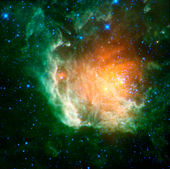
The spectacular infrared image shows the Berkeley 59 cluster of young stars, each of which is just a few million years old, as blue dots just to the right of the center of a dust cloud awash in red and green hues, leading NASA scientists to liken it to a giant cosmic rose.
The new image was taken by NASA's new Wide-field Infrared Survey Explorer (WISE), a $320 million space observatory built to map the entire sky in unprecedented detail. The infrared space telescope has already recorded stunning images of dark asteroids and comets that were previously unseen because they were hard to spot in the visible light range of the spectrum.
WISE's view of Berkeley 59 also includes a "champagne flow" of material resulting from the supernova remnant NGC 7822, an exploded star associated with the region, said officials with NASA's Jet Propulsion Laboratory (JPL) located in Pasadena, Calif. The objects are located in the constellation Cepheus about 3,300 light-years from Earth.
The dust's red glow stems from heat shed by the stars, while green regions outline the fringe of the cloud. The photo's green regions owe their emerald hues to molecules of a compound called polycyclic aromatic hydrocarbons, which can also be commonly found on Earth in the soot from barbeque pits, exhaust pipes and other combustion effects.
NASA's WISE telescope is expected to complete its first all-sky map in about six months.



Reader Comments
to our Newsletter